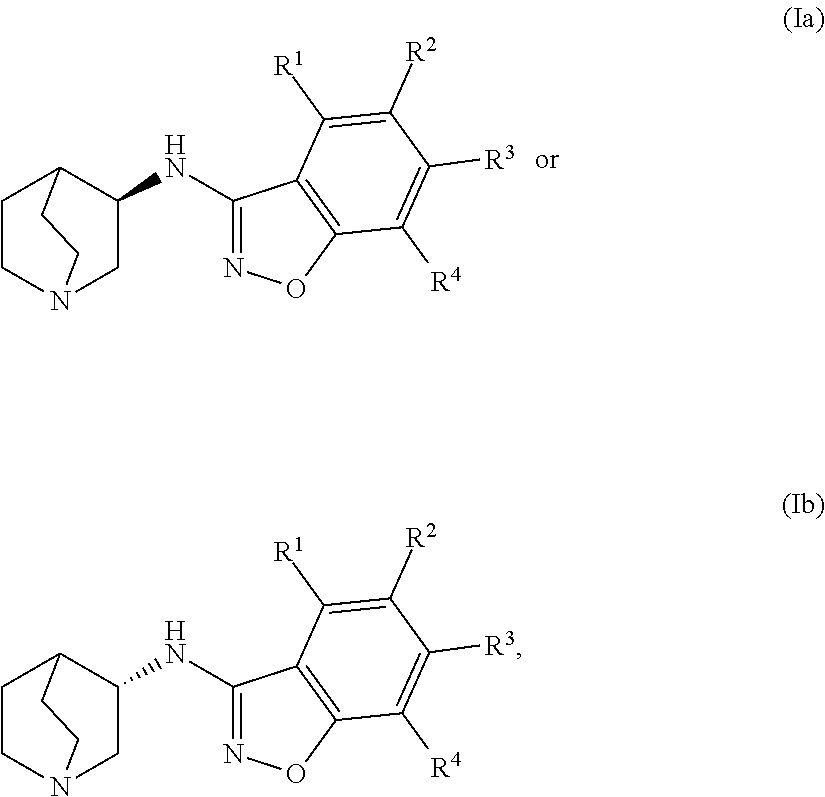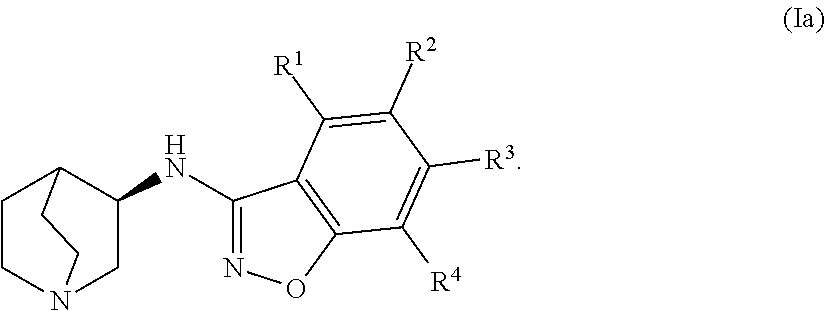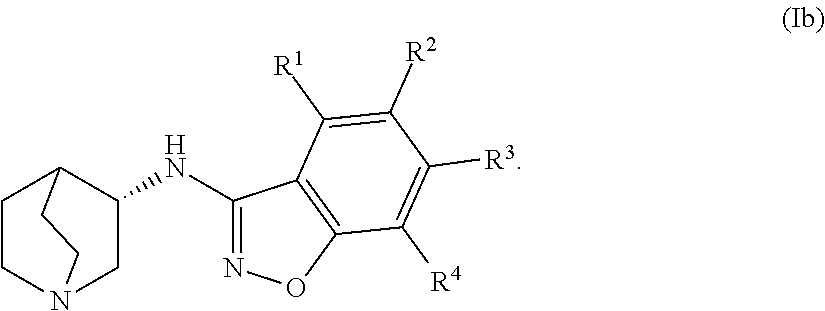Aminobenzisoxazole compounds as agonists of α7-nicotinic acetylcholine receptors
a technology of benzisoxazole and 7-nicotinic acetylcholine, which is applied in the field of aminobenzisoxazole compounds, can solve the problems of steadily growing medical and social problems of cognitive diseases, and achieve the effects of preventing deterioration, minimizing progression, and improving cognition
- Summary
- Abstract
- Description
- Claims
- Application Information
AI Technical Summary
Benefits of technology
Problems solved by technology
Method used
Image
Examples
example 1a
7-chlorobenzo[d]isoxazol-3-amine (A-1)
[0434]
[0435]To a solution of N-hydroxyacetamide (3.6 g, 48 mmol) in dry N,N-dimethylformamide (60 mL) at room temperature was added potassium t-butoxide (5.4 g, 48 mmol). After stirring for 30 minutes, 3-chloro-2-fluorobenzonitrile (5.0 g, 32 mmol) was added, and stirring was continued for another 4.5 hours. On completion, the reaction mixture was poured into a mixture of brine (60 mL) and ethyl acetate (60 mL). The organic phase was separated, dried over anhydrous sodium sulfate, filtered and concentrated to dryness. The residue was purified by silica gel chromatography [petroleum ether:ethyl acetate=3:1] to afford compound A-1 (3.9 g, 73% yield) as a pale yellow solid. 1H-NMR (DMSO-d6, 400 MHz): δ 7.82-7.80 (d, J=7.6 Hz, 1H), 7.65-7.63 (d, J=7.2 Hz, 1H), 7.30-7.26 (m, 1H), 6.61 (s, 2H).
example 2a
6-chlorobenzo[d]isoxazol-3-amine (A-2)
[0436]
[0437]To a solution of N-hydroxyacetamide (3.1 g, 41 mmol) in dry N,N-dimethylformamide (60 mL) at room temperature was added potassium t-butoxide (4.6 g, 41 mmol). After stirring for 30 minutes, 4-chloro-2-nitrobenzonitrile (5.0 g, 27 mmol) was added, and stirring was continued for another 4.5 hours. On completion, the reaction mixture was poured into a mixture of brine (60 mL) and ethyl acetate (60 mL). The organic phase was separated, dried over anhydrous sodium sulfate, filtered and concentrated to dryness. The residue was purified by silica gel chromatography [petroleum ether:ethyl acetate=3:1] to afford compound A-2 (3.1 g, 66% yield) as a pale yellow solid. 1H-NMR (DMSO-d6, 400 MHz): δ 7.84-7.82 (d, J=8.8 Hz, 1H), 7.65-7.64 (d, J=1.2 Hz, 1H), 7.33-7.31 (dd, J=1.2 Hz, J=8.8 Hz, 1H), 6.52 (s, 2H).
example 3a
5-chlorobenzo[d]isoxazol-3-amine (A-3)
[0438]
[0439]To a solution of N-hydroxyacetamide (2.2 g, 29 mmol) in dry N,N-dimethylformamide (30 mL) at room temperature was added potassium t-butoxide (3.2 g, 29 mmol). After stirring for 30 minutes, 5-chloro-2-fluorobenzonitrile (3.0 g, 19 mmol) was added, and stirring was continued for another 4.5 hours. On completion, the reaction mixture was quenched with water and extracted with ethyl acetate (3×20 mL). The combined organic layers were washed with water and brine (5×50 mL), dried over anhydrous sodium sulfate and concentrated in vacuo. The residue was purified by silica gel chromatography [petroleum ether:ethyl acetate=1:1] to afford compound A-3 (1.5 g, 31% yield) as a white solid.
PUM
| Property | Measurement | Unit |
|---|---|---|
| Pressure | aaaaa | aaaaa |
| Temperature | aaaaa | aaaaa |
| Pressure | aaaaa | aaaaa |
Abstract
Description
Claims
Application Information
 Login to View More
Login to View More - R&D
- Intellectual Property
- Life Sciences
- Materials
- Tech Scout
- Unparalleled Data Quality
- Higher Quality Content
- 60% Fewer Hallucinations
Browse by: Latest US Patents, China's latest patents, Technical Efficacy Thesaurus, Application Domain, Technology Topic, Popular Technical Reports.
© 2025 PatSnap. All rights reserved.Legal|Privacy policy|Modern Slavery Act Transparency Statement|Sitemap|About US| Contact US: help@patsnap.com



